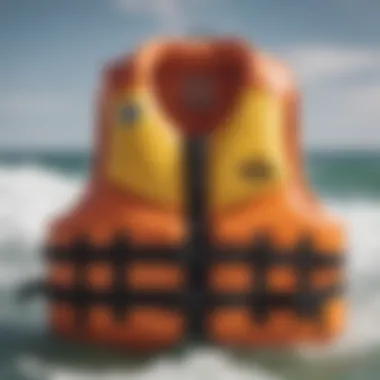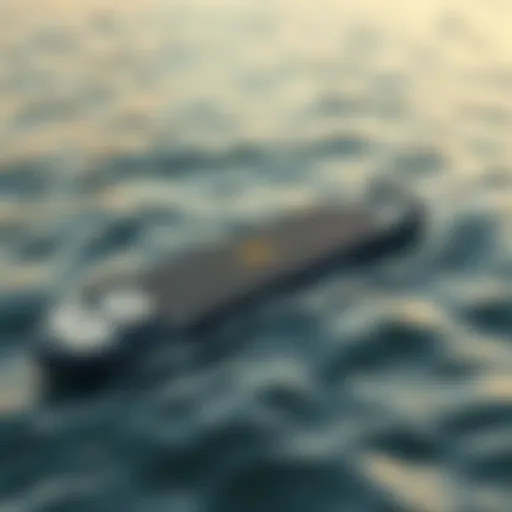Essential Guide to Surfing Life Vests for Safety


Intro
When it comes to riding the waves, safety should never take a back seat. While the thrill of surfing can be exhilarating, it inherently includes some risks. One of the most prudent decisions a surfer can make is opting for a life vest. This essential piece of gear not only provides buoyancy but also enhances your overall surfing experience. Navigating through the various designs, functionalities, and materials of surfing life vests can seem daunting. But don’t let that make you wary. This article sheds light on everything you need to know about choosing, using, and maintaining a life vest tailored to your surfing style.
Gear Insights
Latest Gear Reviews
As technology continues to evolve, so does the design of life vests. Currently, some standout options on the market include the O'Neill Superlite USCG Life Vest and the Mystic Marshall Impact Vest. These products are gaining traction among surfers, offering a blend of comfort, safety, and versatility.
- O'Neill Superlite USCG Life Vest: This vest is designed for maximum flotation yet remains lightweight. It features a comfortable fit, thanks to its adjustable straps. It's perfect for those who enjoy long sessions on the waves without feeling weighed down.
- Mystic Marshall Impact Vest: A great option for surfers who prioritize both safety and style. Made with high-quality neoprene, it provides excellent protection and flexibility without compromising movement.
When evaluating life vests, consider not just the brands but also the specific features they offer. A vest that allows for a full range of motion is vital when catching a wave or paddling out.
Essential Gear for Beginners
For those just starting out in surfing, selecting the right life vest is crucial. Here are a few pointers:
- Buoyancy: Beginners should look for a vest that provides ample buoyancy, helping to stay afloat more easily.
- Fit and Comfort: Make sure the vest fits snugly but doesn’t restrict movement. A good fit often comes from adjustable straps.
- Visibility: Bright colors can be a lifesaver in crowded waters. Choose a vest that stands out.
Diving into the world of surfing can feel overwhelming at first, but a good life vest serves as a foundation for building confidence on the water.
Understanding the Importance of Safety
The primary function of a life vest is to keep a surfer afloat. While many surfers are adept swimmers, situations can arise where even the strongest can struggle. A well-designed vest can mean the difference between a fun day in the sun and a dangerous situation.
"Safety first! A simple life vest can turn a thrilling experience into a safe adventure."
Additionally, regulations can vary by location. It’s always a good idea to check local laws regarding buoyancy aids to ensure you’re compliant while enjoying the waves. Acquainting yourself with these rules can also save you from fines or other inconveniences.
Looking After Your Gear
Maintaining your life vest is essential for its longevity and effectiveness. Here are some tips for keeping your vest in top shape:
- Rinse after use: Saltwater can deteriorate materials. Rinsing with fresh water helps.
- Dry it properly: Avoid direct sunlight while drying; instead, lay it flat in a shaded area.
- Store it correctly: Keep it in a cool, dry place away from sharp objects that might cause damage.
Following these simple care steps ensures that you can rely on your vest for many surf sessions to come.
Epilogue
As you gear up for your next surfing adventure, remember that a life vest is not just a legal requirement but also a wise investment in your safety. Understanding the essentials—from gear selection and maintenance to the nuances of local regulations—will enhance your surfing experience and allow you to focus on what really matters: the waves. Choose wisely and enjoy every swell!
Preface to Surfing Life Vests
When you mention surfing, images of sparkling blue waters, adventurous waves, and the thrill of riding the tide often come to mind. Amongst this excitement lies a crucial element that shouldn't be overlooked: the life vest. It serves not simply as a buoyancy aid but as a lifeline in precarious situations. The integration of this safety gear into the surfing experience transforms it into an act of both adventure and prudence.
Choosing the right life vest is vital for enthusiasts across the spectrum—whether you're just paddling out or performing advanced tricks on the waves. The diverse range of options available today caters to specific needs, enhancing safety without compromising mobility. So, understanding the fundamentals of these vests can make a significant difference in your surfing journey.
The Importance of Safety in Surfing
Let’s face it: surfing is exhilarating, but it isn’t without risks. Waves can be unpredictable. Strong currents can pull even experienced surfers out to sea. The use of life vests plays a crucial role here; they add a layer of confidence, particularly for those still honing their skills. Notably, many beginners or intermediate surfers often emphasize their comfort in the water while wearing a vest, recognizing its role in boosting their overall experience.
"The ocean is a master of surprise. A simple paddling session can turn into an adventure requiring swift navigation."
Safety statistics bear weight. Organizations like the World Surf League advocate for wearing life vests as part of a comprehensive safety kit. Additionally, life vests come with features such as high visibility colors, making it easier for rescuers to locate individuals in distress. It’s a small step that can potentially save lives.
How Life Vests Have Evolved
Surfing life vests today are not the bulky, uncomfortable options that existed decades ago. Gone are the days when they felt more like a life raft strapped to your body. Recent innovations have led to sleek, lightweight designs that enhance flexibility while still maintaining buoyancy. The modern vest is crafted from advanced materials like neoprene and other synthetic textiles that are both durable and water-resistant.
This evolution isn't just about aesthetics or comfort—it's a response to the increased awareness about safety in adventure sports. Over the years, as demand surged for vests that accommodated not just safety but also functionality, manufacturers stepped up to the plate. Notably, surf-specific designs have emerged that consider paddling dynamics and wave mechanics, ensuring they serve their purpose without impeding the rider.
In a nutshell, the journey from the past to present has been a transformative one. Now, more than ever, the importance of life vests in surfing is undeniably underscored by both their evolution in design and the critical role they play in promoting safety while navigating those thrilling waves.
Types of Surfing Life Vests
Understanding the different types of surfing life vests plays a crucial role in enhancing safety while out on the water. This section delves into the distinct categories and what each offers, allowing surfers to choose wisely based on their needs and preferences. Selecting the right type can significantly influence a surfer’s comfort, performance, and, most importantly, their safety during rides. The world of surfing is as wide as the ocean itself, and so are the options when it comes to life vests.
Buoyancy Aids


Buoyancy aids are tailored for those who are looking for some extra flotation without compromising agility in the water. They provide a lightweight solution, which helps maintain the user's buoyancy but allows for a freer range of motion. Ideal for beginners or those who might feel a bit unsteady, these vests are an excellent companion on calmer waves.
When opting for buoyancy aids, consider the following:
- Material: Often constructed from foam or neoprene, they're designed to be both flexible and durable.
- Fit: A snug fit ensures optimal safety. Beware of vests that are too loose, as they may not perform as expected in rougher waters.
The primary benefit is the comfort they provide and how they blend seamlessly into the surfer's overall gear. Similar to a second skin, they give a sense of security without feeling restrictive.
Impact Vests
The focus shifts to impact vests, which are specifically engineered to withstand the rigors of surfing. These vests offer high levels of protection against jolts and falls, crucial for aggressive maneuvers or heavy surf conditions. A thick layer usually made from high-density foam is placed strategically, providing vital protection to the torso.
The benefits of choosing an impact vest are numerous:
- Protection: Shields against sudden impact when wiping out or colliding with the surfboard.
- Comfort: While they may feel bulkier than buoyancy aids, modern designs ensure that mobility is not sacrificed.
For those who enjoy pushing boundaries, these vests can be a lifeline. It’s common to hear surfers share stories of gnarly crashes, and an impact vest can make all the difference.
Full-Floating Vests
Full-floating vests are essentially the heavyweights in the life vest family, offering maximum buoyancy. They are excellent for those who might find themselves in choppy waters or for surfers who are still learning the ropes of handling their boards.
What to keep in mind with full-floating vests:
- Size and Weight: They are bulkier compared to other vests, which may restrict movement slightly compared to buoyancy aids.
- Buoyancy Features: They are designed to keep the body afloat in a way that allows for limited movement but substantial safety.
These vests are particularly favored in challenging surf environments or by individuals who might be more prone to wipeouts. The feeling of security knowing that you can stay afloat under stress provides invaluable peace of mind.
"Choosing the right type of life vest isn't just about comfort; it's about considering the type of conditions and your skill level. What works for one may not necessarily work for another."
Key Features of Life Vests
When it comes to surfing, a life vest is not just an accessory; it's a necessity. Selecting the right vest can mean the difference between a fun day on the waves and a potentially dangerous situation. The key features of life vests must be scrutinized to ensure they meet the individual needs of surfers. Here's a closer look at what those essential features are and how they impact performance, safety, and comfort.
Material and Construction
The materials chosen for life vests play a crucial role in their overall performance and durability. Most surfing life vests are made from either neoprene or a combination of polyester and foam. Neoprene is favored for its elasticity, allowing for greater flexibility when paddling or riding a wave. It retains warmth, which can be particularly beneficial in cooler waters.
In contrast, vests with a polyester outer often feature a foam core that provides buoyancy while being lightweight. The construction quality is equally important.
"A life vest that is stitched carefully can withstand better wear and tear from ocean elements than poorly constructed ones."
When looking at a life vest, pay attention to the stitching, seals, and zippers, as these can greatly affect longevity and safety.
Fit and Comfort
Fitment is paramount, especially in a sport as dynamic as surfing. A vest that is too loose can lead to unwanted movement in the water, reducing effectiveness while a vest that’s too tight may hinder mobility. Many modern vests come with adjustable straps, allowing a personalized fit that caters to individual body types. This adaptability can dramatically improve the surfing experience.
Comfort goes beyond mere fit, however. Breathable materials and designs that allow for a full range of motion while paddling or catching waves are important as well. The vest shouldn’t feel like a straightjacket, so options with built-in ventilation or lighter materials can contribute ensure surfers stay cool and agile even when they’re neck-deep in waves.
Buoyancy Levels
Buoyancy is one of the most critical features in life vests. It directly influences both safety and performance in the water. Different vests offer varying levels of buoyancy, often indicated in pounds. Surfers should assess their own skill levels and how they intend to use the vest. For instance, beginners might opt for vests with higher buoyancy levels to boost confidence as they learn the ropes. Conversely, more experienced surfers may prefer low-buoyancy vests that allow for enhanced maneuverability on the board.
It’s also worth mentioning that buoyancy isn’t just about staying afloat. A vest that provides adequate buoyancy can also help surfers recover after a wipeout, making it easier to return to the surface and get back in the game quickly. Here, a careful balance must be struck between safety and the ability to perform tricks or execute advanced techniques.
In summary, understanding the key features of life vests is essential for any surfer, regardless of their skill level. Assessing the materials used, ensuring an appropriate fit, and understanding buoyancy levels all contribute to a safer and more enjoyable surfing experience.
Choosing the Right Life Vest
Selecting the appropriate life vest is more than just a safety precaution; it’s a pivotal decision that affects your overall surfing experience. The right vest not only keeps you afloat but also ensures you remain comfortable and protected while engaging with the waves. As any seasoned surfer would tell you, there’s no one-size-fits-all in life vests. The perfect vest evolves based on your personal needs, skill level, and environmental conditions. It’s like choosing the right tool for a job—gear that feels right helps elevate your performance.
Assessing Your Needs
Diving into the details of what you need from a life vest is crucial. Ask yourself, what do you plan to do while surfing? Are you tackling mellow waves or are you pushing the boundaries with extreme conditions? Understanding your surfing habits is vital.
- Style of Surfing: If you prefer leisurely paddles, a simpler buoyancy aid might do just fine. Conversely, if your skill set has you plunging into powerful barrels, you might consider a full-floating vest that offers more support.
- Personal Preferences: Some individuals prioritize freedom of movement while others may lean towards extra padding for impact protection. Determine what makes you feel at ease in the water.
- Health and Age Considerations: A younger or stronger person might opt for a sleek vest, while those with more experience or health concerns could benefit from a bit more buoyancy and coverage.
Considering Your Skill Level


Your skill level plays a significant role in the selection process. The more adept you are, the more your choices will widen.
- Beginners: It’s prudent for new surfers to choose vests that maximize buoyancy and stability. A well-fitted full-float vest can do wonders to build confidence in the water.
- Intermediate Surfers: Once you've honed your skills, you might want to explore impact vests that provide protection without sacrificing too much movement.
- Advanced Surfers: For those who think they’ve mastered the waves, lightweight, low-profile vests can balance safety with agility. The goal is to have that second skin feeling—something that disappears while you ride the waves.
Environmental Factors
The water conditions where you surf can make a massive difference in what vest you should choose. Factors include:
- Ocean Temperature: Colder waters necessitate vests made with insulated materials, while warmer climates allow more lightweight options.
- Wave Conditions: Surfing in choppy waters calls for robust designs that can withstand rough handling, as opposed to calmer waters where flexibility is more achievable.
- Location Specifics: If you're heading to a region with sharp rocks or coral reefs, consider impact protection in your vests to guard against injuries.
"Choosing the right life vest is an investment in your safety and surfing enjoyment. Different strokes for different folks, but we’ve all got one goal—getting back on the board after a wipeout!"
Safety Regulations and Standards
When it comes to surfing life vests, safety regulations and standards are vital. These guidelines help ensure that the gear you choose meets specific safety requirements to protect you while on the water. This section dives into the essential industry standards and local regulations, highlighting their significance for all surfers, from seasoned pros to weekend warriors.
Industry Standards for Life Vests
Surfing life vests must adhere to strict industry standards, which are often outlined by organizations like the American Society for Testing and Materials (ASTM) and the National Association of State Boating Law Administrators (NASBLA). These standards specify the buoyancy, design, and construction materials used in life vests. By complying with these regulations, manufacturers assure that their products provide reliable flotation and minimize risks.
- Buoyancy Requirements: Life vests must offer specific levels of buoyancy based on weight categories. If a vest isn’t up to par, it might not perform in critical moments when you need it the most.
- Design Specifications: Vests are designed to fit snugly without restricting movement. Our experience shows that a well-fitting vest can significantly improve a surfer's comfort, leading to a better performance on the waves.
- Material Durability: Regulations can dictate the materials used in vests, ensuring water resistance, UV protection, and longevity. This matters, especially when exposed to saltwater and the sun.
Failing to adhere to these standards doesn’t just compromise safety; it can also affect insurance coverage in the event of an accident. Thus, picking a vest that checks all these boxes is non-negotiable for serious surfers.
Local Regulations to Consider
On top of national standards, local regulations must be taken into account. Different regions may have their own laws regarding life vest usage, particularly in places with high surf or strong tides.
- State Mandates: Some states have specific requirements for life vest usage, especially for beginners or young surfers. In various locales, it is mandatory to wear a vest in certain conditions, like when the waves exceed a certain height or when a beginner is learning.
- Enforcement Norms: Local water patrols might enforce these regulations differently. It’s crucial to familiarize yourself with local laws. A simple chat with a surf instructor or local surf shop can clear things up.
- Environmental Considerations: Coastal areas with strong currents or unique wildlife may also have additional regulations to protect both surfers and marine life. Knowing these can help you stay safe while also respecting the local ecosystem.
Keep in Mind: Always check local regulations before hitting the waves. Compliance not only enhances your safety but also ensures you enjoy your time without unnecessary hassles.
Having a general sense of the industry standards and local regulations can go a long way in ensuring that your surf experience is not only fun but also safe. Picking the right life vest that meets these regulations is an investment in your safety and enjoyment on the water.
Maintenance and Care of Life Vests
Maintaining your surfing life vest is not just a chore but a vital aspect of ensuring safety and performance on the water. Proper upkeep can prolong the life of the vest and enhance its efficiency, making it an essential element for any surfer’s gear. Neglecting care can lead to diminished buoyancy and an increased risk during activities. Here are some key elements worth considering for the longevity and reliability of these safety devices.
Cleaning Techniques
Cleaning a life vest isn't about giving it a once-over but more about treating it like a valuable part of your surf gear. Saltwater, sand, and even sunscreen can take a toll if left unattended. Here are effective cleaning techniques that won't take you away from your surfing too long:
- Rinse Immediately: After each use, especially in saltwater, give your life vest a good rinse. This helps to remove salt and debris that can accumulate and cause material deterioration.
- Gentle Scrubbing: For stubborn spots or accumulated grime, use a soft brush. A gentle scrub with warm water and mild soap can make a world of difference. Just avoid harsh detergents that can lead to degradation of materials.
- Drying Smart: After rinsing, hang your vest in a shaded area to dry. Direct sunlight can wear out the fabric over time and compromise the integrity of the vest. Ensure it’s completely dry before storing it away.
Keeping it clean not only maintains appearance but also ensures that the life vest performs as designed when you hit the waves.
Storage Considerations
How you store your life vest can impact its lifespan significantly. If you're merely tossing it on a pile of your gear, think again. Proper storage helps to preserve the materials and avoids any shape distortion.
Here are practical storage considerations to keep in mind:
- Use a Dry Area: Store the vest in a moisture-free space, as humidity can lead to mold or mildew. A cool, dry room works wonders.
- Avoid Heavy Pressure: Don't stack heavy items on top of your vest while it's in storage. This can cause unnecessary creases or damage the buoyancy chambers inside.
- Avoid Prolonged Folding: Whenever possible, keep the life vest flat rather than folded or crumpled. If you must fold it, avoid folding it along the seams to reduce stress on the fabric.
“Prolonging the life of your gear means you can focus on what really matters – catching waves.”
Taking these little care steps in cleaning and storing can add years to your vest’s life and keep you safe on the water. After all, being prepared is a core part of surfing's spirit, and your gear deserves that same respect.
Technological Innovations in Life Vests
In recent years, the world of surfing life vests has seen a remarkable shift thanks to technological innovations. It's not just about keeping afloat anymore; these advancements focus on enhancing safety, comfort, and performance. The integration of new materials and smart technology in life vests plays an essential role in ensuring that surfers can navigate the waves with confidence.
The importance of these innovations cannot be overstated. When you're out there battling the swells, every element of your gear contributes to your overall experience. A life vest that fits poorly or doesn't perform well can detract from your focus on the ride. Therefore, the evolution of life vests is crucial in adapting to the demands of modern surfers.
Materials Advancements
One of the most significant leaps in life vest technology is the advancements in materials used in their construction. Traditional vests were often bulky and cumbersome, which hindered movement. However, today's vests are crafted from lighter and more durable materials like neoprene and nylon blends.
These materials not only provide superior buoyancy but also ensure flexibility. Surfers can now paddle, jump, and maneuver more freely without feeling restricted by their gear. Additionally, some manufacturers are using eco-friendly and recycled materials to cater to environmentally conscious surfers.


Another noteworthy innovation is the inclusion of breathable fabrics. These allow for better temperature regulation, reducing overheating during strenuous sessions. Models with moisture-wicking technology can draw sweat away from the skin, keeping surfers dry and comfortable.
Smart Vests and Connectivity
The rise of smart vests marks a fascinating direction in life vest technology. These vests often come equipped with sensors and connectivity features that monitor the wearer’s physical condition in real-time. They can track heart rate, body temperature, and even hydration levels, providing critical data that can enhance performance and safety.
Imagine riding the waves while your vest quietly feeds insights to a paired app on your smartphone or smartwatch. This allows surfers to gauge their fatigue levels, manage hydration, and avoid overexertion during extended surf sessions. Furthermore, some smart vests incorporate GPS functionality, which enables tracking of location and surf spots—these features enhance safety in case of emergencies.
"A well-designed smart vest is more than just a piece of equipment; it's a vital companion on the water that augments safety and performance."
These technological innovations do not merely make surfing life vests more advanced; they transform the way surfers interact with their equipment. Innovations in materials and smart technology are paving the way for a safer, more enjoyable surfing experience. As the industry continues to develop, one can only expect further enhancements that will redefine how we look at safety on the waves.
The Impact of Life Vests on Performance
The importance of life vests in surfing goes beyond mere safety; they play a significant role in a surfer's overall performance. Wearing a life vest can be the difference between a good session on the waves and one spent struggling against the tide. Additionally, the right life vest can enhance balance, stabilization, and confidence in the water, which are key components for any surfer looking to push their limits. With that in mind, let’s break this down into specific elements that detail how life vests can impact performance.
Mobility Considerations
When considering life vests, mobility stands out as a crucial aspect. Surfers need the freedom to paddle, pop up quickly, and maneuver across waves with ease. A life vest that restricts movement can hinder a surfer's ability to perform tricks or stay balanced during rapid changes in the water. This is where design becomes important; modern life vests are crafted to provide optimal buoyancy without compromising mobility.
- Cutting-edge Design: Many brands utilize advanced materials that are lighter and more flexible. Such designs allow for more natural body movements which can contribute to overall performance.
- Streamlined Profiles: A vest that fits snugly without excess bulk can dramatically improve a surfer's mobility. Cutting down on drag is essential, especially when catching waves or paddling out.
- Adjustable Features: Many high-quality life vests come with adjustable straps and closures, allowing for a custom fit. This means the vest won’t ride up or restrict the surfer’s movements, ensuring full range of mobility.
In short, surfers must balance safety with the need for agility. A well-fitted life vest that allows freedom of movement can mean the difference between a graceful wipeout and an awkward fall in the water.
Effects on Surfing Technique
Wearing a life vest can also significantly affect a surfer’s technique. Surfers need to be conscious of how their gear influences their style and performance in the water. Here’s a closer analysis of how life vests can impact surfing techniques:
- Paddling Efficiency: A buoyant life vest can assist in paddling, giving extra lift and helping surfers conserve energy. This can lead to improved stamina during longer sessions.
- Stability in the Water: The right vest adds buoyancy that can enhance overall stability. When a surfer feels secure, they're more likely to focus on their technique rather than worrying about swimming back after a fall.
- Impact Absorption: High-quality life vests are designed not only for flotation but also for impact. An impact vest provides additional cushioning when a surfer falls, allowing them to maintain control over their technique rather than succumbing to panic after a collision with the water.
In essence, a well-chosen life vest can enhance a surfer's performance by complementing their technique rather than hindering it. Becoming aware of how the shape, fit, and buoyancy interact with personal surfing style will ultimately be beneficial.
"The right life vest doesn’t just keep you afloat; it’s an extension of your own body, influencing how you ride the waves."
User Reviews and Recommendations
When considering a surfing life vest, user reviews and recommendations can often carry more weight than the most polished marketing brochure. Real-life experiences from fellow surfers provide insights that translate directly into practicality. After all, what good is a vest that claims to be the best if it can't hold up when you're out in the surf, waiting for the perfect wave?
User feedback can illuminate not only performance but also comfort and durability. Have surfers reported chafing after a day spent catching waves? Or do they rave about how well a particular vest fits? This kind of information helps potential buyers decide which features matter most to them. Plus, knowing how different models fare in actual conditions can prevent costly mistakes, further underscoring the importance of community opinions.
Community Feedback
Community feedback can often shed light on user experiences that may not be apparent at first glance. Reviews on platforms like Reddit or specialized surfing forums can draw attention to a jacket's responsiveness or buoyancy in real situations. For instance, someone might mention how a particular model excels in high waves but feels cumbersome during calmer days.
- Pros shared by community members include:
- Ease of movement in the water
- Comfort during prolonged use
- Resistance to wear from saltwater exposure
However, there are sometimes concerns as well. A reviewer may highlight instances of defects or issues regarding sizing. Taking these collective opinions into account paints a clearer picture of what to expect from different brands and models.
Expert Endorsements
While community feedback offers a grassroots perspective, expert endorsements can lend credibility to specific brands or designs. Often, these endorsements can be found in blog articles, equipment reviews, or professional surfer testimonials, emphasizing factors like design innovation and safety standards.
Industry experts typically possess deep knowledge of safety measures and technical advancements in life vest manufacturing. They may identify vests that integrate cutting-edge materials designed to enhance buoyancy or suppress water drag. An expert might also compare various models directly, helping buyers sift through options with a critical eye.
It's beneficial to pay attention to these recommendations if one is serious about investing in a life vest suited not only for recreational use but also for serious surfing endeavors. Moreover, finding an endorsement from a respected figure in the sport can provide the extra layer of assurance needed when making that purchase.
"Choosing a life vest is not just about safety; it's about enhancing your surfing experience while safeguarding the joy of the sport itself." - Surf Industry Expert
Epilogue
In a sport like surfing, the balance of thrill and safety is all wrapped up in the experience. The right life vest can mean the difference between an exhilarating day riding waves and an unfortunate accident. This article has explored various facets of surfing life vests, from their evolving designs to the myriad types that cater to distinct needs. As surfing continues to capture the hearts of adventurers and professionals alike, understanding the importance of these safety devices has never been more crucial.
Summary of Key Takeaways
Reflecting on the discussion in this article, several key points stand out:
- Safety First: Always prioritize safety and comfort. A well-fitting and appropriate life vest can significantly reduce the risks associated with surfing, ensuring that both novice and seasoned surfers can enjoy their time in the water with peace of mind.
- Types of Vests Matter: Not every vest is suitable for every surfer or situation. From buoyancy aids designed for beginners to full-floating vests suited for strong swimmers, understanding the types helps in selecting the right equipment for your needs.
- Choose Wisely: Factors like material, fit, and buoyancy levels play a crucial role in vest selection. Also, remaining aware of environmental conditions can guide your choice effectively.
“A life vest is not just a piece of equipment; it's an essential companion on your surfing journey.”
Future Trends in Surfing Life Vests
Looking forward, the landscape of surfing life vests is poised for exciting advancements. Here are a few trends to watch:
- Smart Technology Integration: Vests are increasingly incorporating technology like GPS, connectivity features, and health-tracking sensors. These innovations aim to enhance safety and user experience, providing real-time information to both surfers and rescue teams.
- Sustainability Focus: As environmental awareness grows, more brands are exploring eco-friendly materials and manufacturing processes. Expect to see vests crafted from recycled or biodegradable materials, pushing forward the trend of sustainability in sports apparel.
- Customization and Comfort: Advances in tailoring options, such as adjustable fittings and modular components, will provide surfers with a more personalized fit and greater mobility on the waves.















